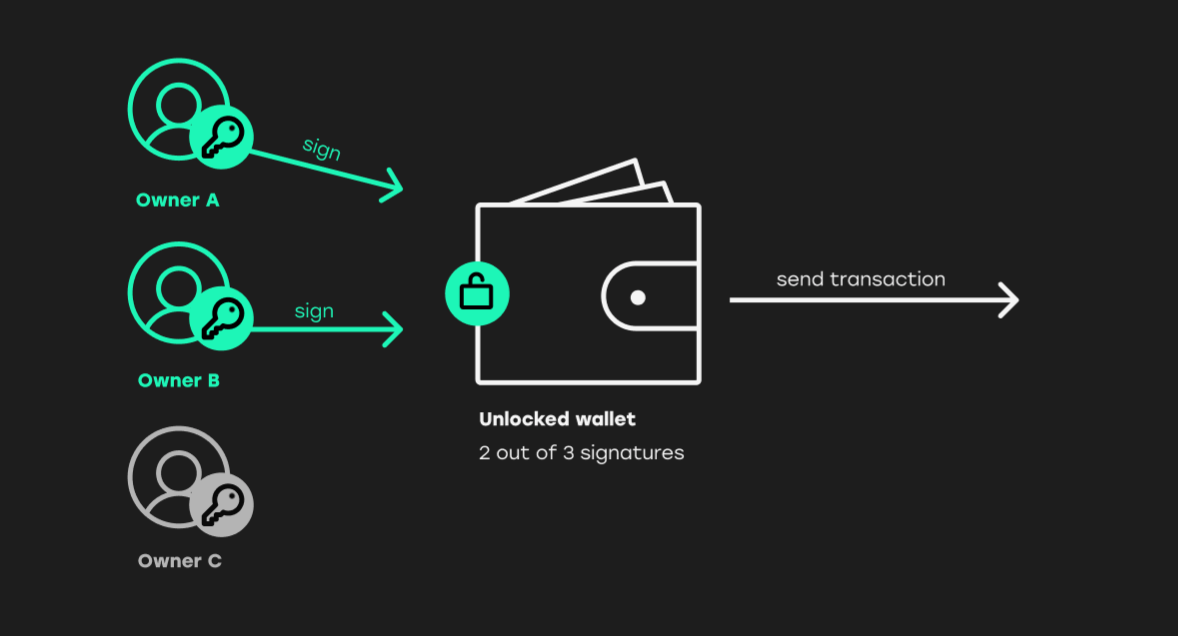Demystifying MultiSig Wallets
 A Alfred Rodriguez
A Alfred Rodriguez
Introduction
In the evolving world of cryptocurrency, understanding the nuances of blockchain technology and crypto wallets is key to navigating these digital waters. The rapid advancement of technology has brought forward various kinds of digital wallets, each with unique features and security mechanisms to offer. One such advanced and intriguing technology is the Multisignature (MultiSig) Wallet.
A step forward from traditional crypto wallets, MultiSig wallets have emerged as a beacon of heightened security in the realm of crypto transactions. As the adoption of cryptocurrency expands across individual investors, businesses, and even governmental organizations, the need for secure transactions has never been more paramount. This form of technology, designed to require multiple authorizations for a transaction, increases security, enhances control, and provides peace of mind for crypto enthusiasts.
Let’s delve deeper into the workings, architecture, and pros and cons of MultiSig wallets, providing an in-depth understanding of this advanced security mechanism in the crypto world.
What is a MultiSig Crypto Wallet?
A MultiSig crypto wallet is essentially a digital wallet that requires multiple signatures to authorize a cryptocurrency transaction. It’s like a digital safety deposit box that needs multiple keys to unlock, instead of just one. This type of wallet is known for enhancing the security of crypto assets, making it significantly more difficult for malicious parties to gain control.
The Architecture of a MultiSig Wallet
At its core, a MultiSig wallet operates using a mechanism known as P2SH (Pay To Script Hash) transactions, a form of transaction introduced in Bitcoin's BIP-16 proposal. In contrast to traditional Bitcoin transactions, where coins are sent to a public key hash, P2SH transactions send coins to a script hash instead.
Here's a deeper dive into how this works:
The Redeem Script: This script defines the conditions that must be met to spend the coins. In the case of a MultiSig wallet, this script would specify that multiple signatures (private keys) are required to authorize a transaction. For example, in a 2-of-3 MultiSig wallet, the redeem script specifies that any two of the three private keys must sign off on a transaction.
The P2SH Address: Once the redeem script is written, it is hashed to create the P2SH address. This address, beginning with a '3' in the case of Bitcoin, serves as the public address for the MultiSig wallet. When someone sends coins to this address, they are essentially locking the coins into the conditions specified by the redeem script.
Transaction Verification: When a transaction is made from the MultiSig wallet, the redeem script is revealed to the network. The network then verifies that the conditions specified by the script have been met - i.e., the transaction has been signed by the required number of keys. If the conditions are met, the transaction is validated, and the coins are successfully spent.
Script Interpreters: Cryptocurrency nodes use script interpreters to validate the conditions specified in the redeem script. These interpreters are part of the broader cryptocurrency protocol and validate transactions against the conditions embedded in the redeem script.
Key Management: In a MultiSig wallet, each key can be managed independently. Keys can be generated, stored, and used on different devices or even held by different individuals, depending on the requirements of the wallet’s users. This flexibility allows for a range of potential use cases, from individual users seeking extra security to organizations needing to distribute control over their funds.
This unique architecture, leveraging P2SH transactions and requiring multiple signatures for authorization, is what provides a MultiSig wallet with its advanced security features. However, it is also this complexity that makes it more difficult to use compared to traditional wallets. This trade-off is an important consideration when deciding if a MultiSig wallet is the right solution for you.
The Working Mechanism of a MultiSig Wallet
To understand the functionality of a MultiSig wallet, we'll consider a 2-of-3 MultiSig wallet. In this scenario, there are three associated keys, but only two are required to approve a transaction. Here's how it works:
Creation of Keys: Initially, three keys are created. These could belong to three different individuals, or the same person using different devices.
Initiation of Transaction: When a transaction is initiated, the first signature is created using one of the keys. However, the transaction remains incomplete.
Approval of Transaction: The second signature, created using a different key, completes the transaction. This dual-approval process ensures an extra layer of security.

Pros of a MultiSig Wallet
Enhanced Security: By requiring multiple signatures to authorize transactions, MultiSig wallets make it harder for hackers to gain control. Even if one key is compromised, the attacker cannot access the funds without the other keys.
Redundancy: MultiSig wallets provide a backup solution. If you lose one key, you can still access your funds with the remaining keys.
Collaborative Control: They are ideal for organizations where multiple stakeholders need control over funds. It ensures transparency and mitigates risks associated with a single point of control.
Cons of a MultiSig Wallet
Increased Complexity: MultiSig wallets are inherently more complex than traditional wallets. The process of creating multiple keys and authorizing transactions can be overwhelming for new users.
Lost Keys: If too many keys are lost such that the required number of signatures can't be met, the funds become irretrievable.
Disputes: In a multi-party setting, disagreements can occur. If consensus isn't reached, the funds may end up inaccessible.
Conclusion
Cryptocurrencies are transforming the financial world, but as we forge ahead into this new digital frontier, it's crucial to prioritize security. The MultiSig wallet, with its multi-layered approach to secure transactions, serves as a safeguard in the crypto universe, defending your digital assets from potential threats. This innovative technology, while relatively complex, adds an unparalleled level of safety, control, and transparency.
Choosing the right wallet for your cryptocurrency needs is a decision of striking the right balance between security, ease of use, and control. The MultiSig wallet, with its unique blend of security and control, may just be the solution for many. However, as the cryptosphere continues to evolve, it's imperative to stay updated and continuously reassess the best options available. In the world of cryptocurrency, knowledge is not just power - it's security.
Subscribe to my newsletter
Read articles from A Alfred Rodriguez directly inside your inbox. Subscribe to the newsletter, and don't miss out.
Written by
